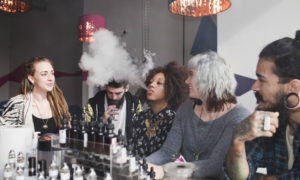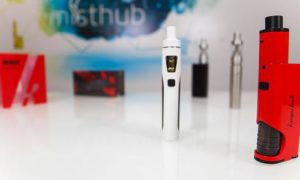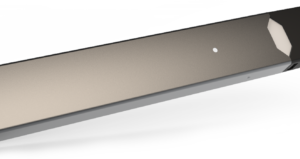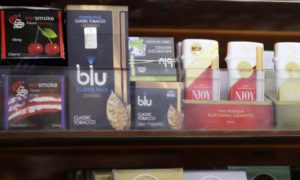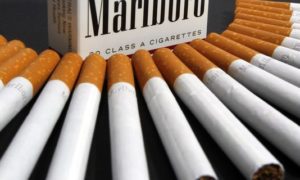It’s hard to imagine, these days, selling a product by calling it synthetic. “A lot of people kind of give you the weird eye,” says Edward Uy, vice president at SQN, the first vaping company to debut liquids with lab-made synthetic nicotine. Every other tobacco product in human history, including virtually every other vaping liquid, makes use of natural nicotine from tobacco plants.
But tobacco also happens to be, if anything, the prime example that natural is not necessarily better. As decades of lawsuits and ads featuring gross black lungs have tanked tobacco’s reputation, one small corner of the vaping industry senses an opening. E-cigarettes vaporize flavored nicotine-infused liquids: no burning tobacco leaves, none of the health impacts of smoke. That nicotine can theoretically come from anywhere. And synthetic nicotine—same molecular formula as the natural version, just as addictive—just might not fall under the Food and Drug Administration’s vaping regulations coming down in August.
That’s why Ron Tully started Next Generation Labs, a small company that makes what it calls “tobacco-free nicotine” for vaping liquid companies like SQN. Tully envisions a world in which people use synthetic nicotine the way they drink booze or dab hash oil—without the black cloud of tobacco’s reputation hanging over the chemically altered fun. Take it from Tully. He spent over 15 years working in the tobacco industry before getting into lab-made nicotine.
Making Nicotine From Scratch
Next Generation Labs is not the first to make synthetic nicotine, but it appears to be the first company to target the vaping market.
Synthetic nicotine tastes better in vaping liquids, says Tully—as in it tastes like nothing. The stuff extracted from tobacco may still have a whiff of plant, which creates off-flavors that liquid manufacturers mask with sweeteners and aggressive flavors. It’s not a coincidence that popular flavors are basically candy.

The downside of synthetic nicotine is cost. SQN uses Next Generation Labs’ synthetic nicotine in three lines—NKTR, NKTR Sour, and Melt—and Uy says it costs 13 times as much as the readily available natural version. Tobacco plants are, after all, very good at making nicotine, thanks to centuries of breeding for just that purpose.
Swiss chemist Amé Pictet synthesized nicotine in a lab for the first time in 1904, but his process—like many others that would come after it—only worked on a small scale. Pictet’s process involved heating a single test tube until it was red hot. When Tully started Next Generation Labs, a team spent two years figuring out how to scale up the process. The final synthesis involves four major steps and takes about a week, with various steps involving heating and cooling to optimize the reactions. Tully declined to detail the synthesis—citing pending three patents.
Tobacco Product Or Not
Since Next Generation Labs nailed down its synthesis, vaping has become massively popular—enough so that it finally attracted the attention of the FDA. Earlier this year, the agency officially said it would regulate e-cigarettes as “tobacco products.”
The agency gets its authority from the Tobacco Control Act, which defines tobacco products as “any product made or derived from tobacco that is intended for human consumption, including any component, part, or accessory of a tobacco product.”
Where does that leave synthetic nicotine, which is not derived from tobacco plants but could be component, part, or accessory of a tobacco product—and is every bit as addictive? Good question, very good question. Tully says he doesn’t think synthetic nicotine should count. He also added, “It’s almost a pointless exercise talking to FDA because they never give you clarity.“ When I asked the FDA the same question about synthetic nicotine’s status as a tobacco product, the agency replied, “These products will be evaluated on a case-by-case basis.”
Given that the FDA has asserted it can regulate even vaping liquids that contain no nicotine though, it does not seem poised to turn a blind eye to synthetic nicotine on technical grounds. Still, nicotine’s origin gives manufacturers some plausible deniability—if not legally, certainly as a marketing tactic. “We just don’t fit that mold because we’re not trying to sell as tobacco product,” says Tully. “We have nothing to do with tobacco.” Except, of course, that nicotine and tobacco have gone hand in hand for hundreds of years.
The New Nicotine?
Carving out that new market for nicotine will require canny messaging. Uy says he’s exploring a trade association for tobacco-free nicotine, rattling off a list of potential members including Coastline, CRFT Labs, and KVASS—all of which have launched liquids with synthetic nicotine and a sleek aesthetic reminiscent of $15 single-source chocolate bars. Don’t expect any Unicorn Puke or Gummi Bear in this club. “We’re looking for companies that are marketing responsibly, don’t use any potential trademark infringement, don’t have cartoons on the outside, exhibit responsibly, and don’t give out free samples,” says Uy.
More on E-Cigs
-
 April Glaser
April Glaser Vape Pens and E-Cigs Are Blowing Up. Like, Literally
-
 Danielle Venton
Danielle Venton The War Over Vaping’s Health Risks Is Getting Dirty
-
 Sarah Zhang
Sarah Zhang The US: E-Cigs Very Bad! The UK: E-Cigs OK! All of Us: Huh?
The comparatively clean flavor of synthetic tobacco, which translates to simpler flavors and fewer sweeteners, is part of that appeal. SQN’s first three flavors with synthetic nicotine were mango, guava, and pear. The company has switched completely over to the synthetic stuff now. Over a dozen brands now use Next Generation Lab’s nicotine.
Next Generation Lab has also trademarked its synthetic nicotine as Pharmanic, a nod to the pharmaceutical industry’s interest in the substance. Nicotine’s buzz comes from its ability to bind to certain receptors in the brain. Pharmaceutical companies are interested in nicotine and its analogues as possible drugs for a range of brain disorders from Parkinson’s to Tourette’s to ADHD. Tully says they’re interested in exploring pharmaceutical partnerships in the future for nicotine or its derivatives. That would, of course, help burnish nicotine’s reputation separate from tobacco.
But it could also cut both ways. Nicotine has a powerful effect on the brain. It is not as dangerous as cigarette smoke, but it can affect brain development in fetuses and children. And it affects the brains of everyone uses it regularly. “Ultimately when you have nicotine, you have a highly addictive product,” says Erika Sward, vice president of national affairs at the American Lung Association. That’s all you need really to keep selling nicotine, synthetic or natural.
Click here to view original web page at www.wired.com



